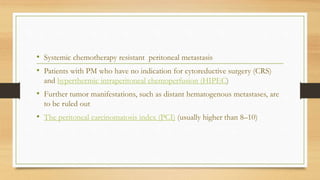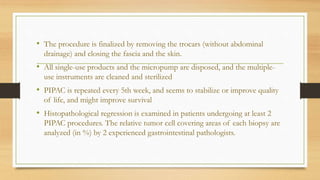Pipac
- 1. Pressurized Intra Peritoneal Aerosol Chemotherapy (PIPAC) Dr. Girish Saini
- 2. OUTLINE • Introduction • Indication • Method • Outcome and Comparison • Complication • Message
- 3. INTRODUCTION • Pressurized Intra Peritoneal Aerosol Chemotherapy (PIPAC) is a minimally- invasive therapy distributing chemotherapy as a pressurized aerosol into the abdominal cavity during laparoscopy. • PIPAC is a drug delivery technique with superior pharmacological properties for treating peritoneal metastasis.
- 4. • PIPAC is a relatively new method to alleviate symptoms, in particular to control ascites and to induce regression of peritoneal metastasis, leading to a better quality of life (QoL).
- 5. ePIPAC • Adding electrostatic loading (electrostatic precipitation PIPAC, ePIPAC) as an adjunct to aerosol form and artificial hydrostatic pressure improved tissue uptake in the preclinical model. • Low-dose PIPAC with cisplatin 7.5 mg/m2 and doxorubicin 1.5 mg/m2 was applied intraperitoneally at a pressure of 12 mmHg and a temperature of 37°C for 30 minutes (off-label use of approved drugs). • Additionally, a voltage 7500-9500 V and a current ≤ 10 µA were applied over a stainless steel brush electrode emitting a stream of electrons
- 6. • The first ePIPAC use in three human patients with histologically proved peritoneal metastasis of hepatobiliary-pancreatic (HBP) origin. • ePIPAC was technically feasible and easy to perform. • The therapeutic aerosol vanished within 30 seconds after electrostatic activation
- 7. INDICATION • Carcinoma ovary • Carcinoma stomach • Colorectal carcinoma • Carcinoma unknown primary • Hepatobiliariy Pancreatic Carcinoma • Appendiceal tumors • Mesothelioma • Others
- 8. • Systemic chemotherapy resistant peritoneal metastasis • Patients with PM who have no indication for cytoreductive surgery (CRS) and hyperthermic intraperitoneal chemoperfusion (HIPEC) • Further tumor manifestations, such as distant hematogenous metastases, are to be ruled out • The peritoneal carcinomatosis index (PCI) (usually higher than 8–10)
- 9. • Patients with progressive disease during systemic chemotherapy and patients with distant metastases other than PM were not eligible for PIPAC. • Precondition to undergo surgery is an Eastern Cooperative Oncology Group (ECOG) performance status of 2 or better, which was re-evaluated before each repeated procedure at intervals of about 6 week
- 10. METHOD • PIPAC procedures is performed laparoscopically under general anesthesia. • The standardized pre-therapeutic diagnostic laparoscopy is video- documented. • Both diagnostic laparoscopy and PIPAC should strictly follow our internal standardized operational procedures and adhered to the surgical safety checklists.
- 11. • A pneumo-peritoneum of 12 mmHg is induced by an open mini-incision (1 cm) with a 12 mm-trocar inserted consecutively under video-optic guidance. • An additional 5 mm trocar is placed into the abdominal cavity under direct visualization. • If ascites is present, it was completely evacuated by suction and quantified (in mL). • The accessibility to the abdomen should described (“access” vs. “non- access”)
- 12. • The adhesion score is assessed and documented if patients have previous surgeries or adhesions due to tumor manifestation, according to the modified method of Coccolini et al. • PCI is evaluated and verified by a second surgeon. • A localized peritonectomy of the best accessible areas of the 4 abdominal quadrants is carried out according to our protocol, and the samples are sent for pathological analysis. • The micro-pump is installed into the 12 mm-trocar and fixed under direct vision.
- 14. • The injection pump is connected • All the staff leave the operating room. • The chemo-distribution of aerosol is initiated and controlled from a footswitch in the preparation room, separated by a closed window from the operating room. • This allowed the monitoring of the laparoscopy tower, the injection pump, and the anesthesia condition of the patients by all the responsible persons.
- 15. • First, cisplatin at a dosage of 7.5 mg/m2 in 150 mL NaCl 0.9%, then doxorubicin at 1.5 mg/m2 body surface in 50 mL NaCl 0.9% are insufflated. • The injection pump delivered the chemotherapy at a maximum pressure of 200 psi and a flow rate of 0.5 mL/min to the micro-pump. • Here, the fluid is transformed to aerosol and applied to the abdomen.
- 16. • A constant pressure of 12 mmHg with a zero flow of CO2 ensure that the patient is relaxed and that the aerosol does not escape from the abdomen. • After this phase of application, the aerosol is kept in the abdominal cavity for 30 minutes. • Finally, the situs are controlled for bleeding and the pump was removed under direct vision. • While the rest of the aerosol and CO2 are transferred into the central ventilation system of the clinic (in analogy to the vent of anesthetic gases) through a closed system.
- 17. • The procedure is finalized by removing the trocars (without abdominal drainage) and closing the fascia and the skin. • All single-use products and the micropump are disposed, and the multiple- use instruments are cleaned and sterilized • PIPAC is repeated every 5th week, and seems to stabilize or improve quality of life, and might improve survival • Histopathological regression is examined in patients undergoing at least 2 PIPAC procedures. The relative tumor cell covering areas of each biopsy are analyzed (in %) by 2 experienced gastrointestinal pathologists.
- 18. • Treatment related toxicity is evaluated after 2 weeks. Response is evaluated histologically by the Peritoneal Regression Grading Score (PRGS) and cytologically by analysis of the lavage fluid. • The biopsy with the maximum tumor cell area is used to evaluate peritoneal regression. Briefly, biopsies are fixed in 4% buffered formalin, embedded in paraffin, cut to 4 µm sections, and stained with hematoxylin and eosin (H&E) using an automated slide strainer.
- 19. OUTCOME • Karnowsky-Index increased significantly • It can induce regression of peritoneal carcinomatosis in end-stage, multi resistant tumors. • It is easy to use, and is well tolerated, a decisive feature in patients with limited life expectancy. • Can be repeated up to 8 times in the same patient • Median postoperative hospital stay was 3 days.
- 20. • Abdominal access is the critical step of the procedure. PIPAC does not induce chemical bowel perforations. • PIPAC is safe and surgical complications are rare
- 21. COMPARISON • Plasma concentration-time profile analysis after PIPAC indicated superior ratio between dose, systemic and local drug concentration: PIPAC required only 1/10th of the doxorubicin dose to achieve higher tumor concentrations (0.03-4.1 µmol/g) as reported for HIPEC (0.02 µmol/g). • In contrast, systemic availability of PIPAC and HIPEC were equal as indicated by the approximately 10-times lower maximal plasma concentrations after PIPAC. • Liver and renal tests showed neither acute nor cumulative toxicity
- 22. COMPLICATION • Adhesions • Bowel perforations • Parietal hematoma • Hospital mortality (0.3%) • Peritonitis (0.15%) • Tumor lysis syndrome (0.15%) • Repeated PIPAC with oxaliplatin can lead to SPS.(Severe Peritoneal Sclerosis)
- 23. Take home message • Peritoneal metastasis and the presence of ascites, is a feature of poor prognosis for patients with stage IV disease • Symptom control and the maintenance of QoL remain the major treatment objectives in the management of patients with stage IV disease. • Options beyond palliative chemotherapy are limited in patients with stage IV disease and peritoneal metastasis.
- 24. • Hence, PIPAC might enrich the portfolio of palliative treatment options with the overall goal of symptomatic improvement and alleviation of QoL- reducing parameters. • Due to its minimal-invasive applicability, low operative risk, and short post- operative in-hospital stay with a good overall tolerability, this additional option in systemic therapy seems acceptable in critically ill patient • In conclusions, PIPAC is not toxic and may nead symptom-oriented optimization with regard to ascites reduction, (partial) macroscopic and histopathologic regression of PM and better QoL.
- 25. • PIPAC has the potential — due to its restricted invasiveness, limited surgical side-effects and risks, and its lack of systemic toxicity — to be used for symptom control in Gastric Cancer patients with disseminated Peritoneal metastasis, in addition to systemic therapy. • However, the predictors of response and the optimum intervals of PIPAC within systemic therapy concepts are yet to be identified in on-going further studies. • Thus, we are not too optimistic that PIPAC will become standard treatment in Gastric Cancer patients with Peritoneal metastasis in the near future.
- 26. Source and Reference 1. Indications and surgical results of Pressurized IntraPeritoneal Aerosol Chemotherapy (PIPAC) for palliative therapy of peritoneal metastasis after 748 consecutive procedures(Marc A Reymond, MD, Cedric Demtroder, MD, Jurgen Zieren, MD, Urs Giger- Pabst, MD, Dirk Strumberg, MD, Clemens B Tempfer, MD. Ruhr-University Bochum) 2. Intraperitoneal Chemotherapy of Peritoneal Carcinomatosis using Pressurized Aerosol as an Alternative to Liquid Solution: First Evidence for Efficacy and Tolerability (Wiebke Solass, MD, Urs Pabst-Giger, MD, Thomas Murdter, PhD, Reinhold Kerb, MD, Matthias Schwab, MD, Jurgen Zieren, MD, Marc A Reymond, MD, MBA. Ruhr-University Bochum, Germany) 3. Electrostatic Precipitation Pressurized IntraPeritoneal Aerosol Chemotherapy (ePIPAC): first in-human application(Marc A Reymond. Ruhr-University Bochum)
- 27. • Gockel I, Jansen-Winkeln B, Haase L, et al. Pressurized Intraperitoneal Aerosol Chemotherapy (PIPAC) in Gastric Cancer Patients with Peritoneal Metastasis (PM): Results of a Single-Center Experience and Register Study. J Gastric Cancer. 2018;18(4):379–391. doi:10.5230/jgc.2018.18.e37 • Jansen-Winkeln B, Thieme R, Haase L, Niebisch S, Pommer C, Lyros O, et al. Perioperative safety of intraperitoneal aerosol chemotherapy: analysis of our first 111 pressurized intraperitoneal aerosol chemotherapy (PIPAC) procedures. Chirurg. 2018 doi: 10.1007/s00104-018-0667-5.
- 28. • Severe peritoneal sclerosis after repeated pressurized intraperitoneal aerosol chemotherapy with oxaliplatin (PIPAC OX): report of two cases and literature survey.(Graversen M1,2, Detlefsen S3,4, Pfeiffer P3,5, Lundell L6,7, Mortensen MB6,3) Clin Exp Metastasis. 2018 Mar;35(3):103-108. doi: 10.1007/s10585-018-9895-9. Epub 2018 Apr 28
- 29. Thank You
- 30. 8
- 31. 9
- 32. 19
































